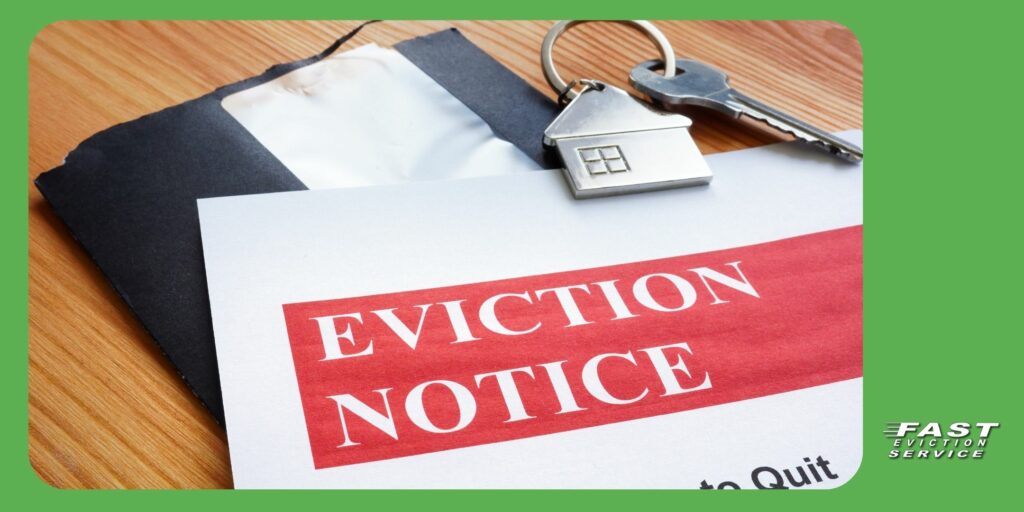The Eviction Process in California: Understanding How Evictions Work
Evicting a tenant is one of the most challenging aspects of being a landlord. Fast Eviction Service has been helping landlords and property managers since 1979.
California has strict tenant protection laws, and navigating the eviction process in California requires careful adherence to legal procedures. Whether dealing with nonpayment of rent, lease violations, or other legal grounds, landlords must understand how to properly handle tenant evictions while complying with state and local laws.
In this guide, we’ll break down each step of the eviction process, from serving notices to filing an unlawful detainer lawsuit in California, and discuss common pitfalls landlords should avoid.
Table of Contents
- What Is the Eviction Process in California?
- Understanding the California Tenant Protection Act of 2019
- Legal Reasons for Evicting a Tenant in California
- Types of Eviction Notices in California and When to Use Them
- How to Serve an Eviction Notice in California
- How to File an Unlawful Detainer Lawsuit in California
- Court Process for an Eviction in California
- How Long Does It Take to Evict a Tenant in California?
- Common Mistakes Landlords Make in the Eviction Process
- What Happens After an Eviction: Tenant’s Property and Next Steps

What Is the Eviction Process in California?
The eviction process in California is a legal procedure that allows landlords to remove tenants who violate lease agreements, fail to pay rent, or engage in illegal activities. Evictions must follow state-mandated steps, and landlords cannot force tenants out by changing locks, shutting off utilities, or using intimidation.
A formal eviction begins with a legally valid tenant eviction notice in California, followed by a court filing if the tenant does not comply.
Understanding the California Tenant Protection Act of 2019
The California Tenant Protection Act of 2019 (AB 1482) was implemented to provide stronger tenant protections against unjust evictions and excessive rent hikes. This law applies to most rental properties across California, particularly those not already covered by local rent control ordinances. Understanding its key provisions is crucial for landlords to ensure compliance and avoid potential legal disputes.
Key Provisions of AB 1482:
- Rent Cap Limitations: The law restricts annual rent increases to 5% plus the local inflation rate, with a total cap of 10% per year. This applies to multi-unit buildings that are more than 15 years old but excludes single-family homes owned by small landlords.
- Just Cause Eviction Requirements: Landlords can no longer terminate a tenancy without a legally valid reason once a tenant has lived in the unit for at least 12 months. Just cause reasons are divided into:
- At-Fault Evictions: These include nonpayment of rent, lease violations, and engaging in criminal activity on the premises.
- No-Fault Evictions: If a landlord needs to move into the unit, remove it from the rental market, or conduct significant renovations, they must provide relocation assistance or waive the tenant’s last month of rent.
- Relocation Assistance for No-Fault Evictions: If a landlord terminates a lease for a no-fault reason, they must provide relocation assistance equal to one month’s rent or waive the final month’s rent.
- Exemptions from AB 1482: Not all rental properties fall under this law. Exempt properties include:
- Single-family homes and condos not owned by corporations.
- Duplexes where the owner lives in one of the units.
- Buildings constructed within the last 15 years.
- Notification Requirements: Landlords must disclose whether their property is subject to AB 1482 protections in all lease agreements.
By understanding and adhering to these regulations, landlords can protect themselves from legal challenges and ensure compliance with California’s evolving tenant laws. Failing to follow these rules can result in fines, tenant lawsuits, and court-ordered penalties.
Landlord’s Rights During the Eviction Process
Understanding landlord rights in the eviction process is crucial for ensuring a smooth and legally compliant procedure. California law protects tenants, but landlords also have specific rights that allow them to regain possession of their rental properties when necessary.
Right to Collect Rent
Landlords have the legal right to collect rent from tenants as per the terms of the lease agreement. If a tenant fails to pay rent, landlords can issue a 3-day notice to pay rent or quit, which starts the eviction process.
Right to Enforce Lease Terms
Landlords can enforce all lease terms agreed upon by both parties. If a tenant violates the lease—such as subletting without permission, keeping unauthorized pets, or causing excessive damage—landlords have the right to issue a notice to cure or quit and take legal action if the issue is not resolved.
Right to Issue a Legal Eviction Notice
When a tenant fails to comply with lease terms or legal requirements, landlords have the right to serve a proper eviction notice, following California’s tenant laws.
Right to Regain Possession of the Property
Once a court rules in favor of the landlord in an unlawful detainer case, the landlord has the legal right to reclaim possession of the unit after the sheriff enforces the Writ of Possession.
Right to Deduct for Damages Beyond Normal Wear and Tear
After a tenant vacates, landlords can deduct the cost of repairs from the tenant’s security deposit, provided they follow California’s security deposit return rules and provide a detailed statement of deductions.
Right to Screen Tenants
To minimize future eviction risks, landlords have the right to screen prospective tenants through background checks, rental history verification, and credit reports, as long as they comply with fair housing laws.
By understanding and exercising these rights, landlords can protect their rental investments, minimize financial losses, and ensure compliance with California’s eviction laws.
Continue reading more about Landlord Rights During the Eviction Process

Legal Reasons for Evicting a Tenant in California
Landlords must have legal grounds to evict a tenant in California. The most common reasons include:
- Nonpayment of Rent – The tenant has failed to pay rent and has not responded to a formal notice.
- Lease Violations – Breaking terms of the lease, such as unauthorized occupants or pets.
- Illegal Activities – Engaging in illegal activities on the property.
- Property Damage – The tenant has caused significant damage beyond normal wear and tear.
- Owner Move-In or Renovation – The landlord needs the property for personal use or major repairs.
Types of Eviction Notices in California and When to Use Them
There are several types of tenant eviction notices in California, each serving a different purpose:
- 3-Day Notice to Quit (California) – Used for serious lease violations, including unpaid rent.
- 30-Day or 60-Day Notice to Vacate – Given for no-fault evictions when the landlord wants to end a month-to-month agreement.
- 3-Day Notice to Cure or Quit – Used for fixable lease violations, giving the tenant a chance to correct the issue.
How to Serve an Eviction Notice in California
Properly serving an eviction notice is crucial to avoid legal delays and ensure that the eviction process moves forward correctly. California law requires landlords to follow strict procedures when serving notices to tenants, and failing to adhere to these guidelines can result in case dismissal or legal challenges.
Methods of Serving an Eviction Notice
- Personal Delivery: The best method is to hand the notice directly to the tenant. This ensures they receive it immediately and eliminates disputes about whether it was delivered.
- Substituted Service: If the tenant is unavailable, the notice can be given to a responsible person at the property, such as a co-tenant or an adult over 18, and a copy must also be mailed to the tenant.
- Posting and Mailing: If personal delivery and substituted service are not possible, the landlord may post the notice in a visible location (such as the front door) and send a copy via certified mail. This method is known as “nail and mail.”
Legal Requirements for Serving an Eviction Notice
- The notice must be clear and specific, stating the reason for eviction and the deadline for compliance.
- If mailing a notice, it must be sent via certified mail with a return receipt requested.
- The landlord should keep detailed records of when and how the notice was served, including taking photos if posted at the property.
Common Mistakes to Avoid When Serving an Eviction Notice
- Using the Wrong Notice Type: Landlords must ensure they issue the correct notice based on the reason for eviction (e.g., 3-day, 30-day, or 60-day notice).
- Failing to Provide Proper Documentation: Courts require proof that the notice was legally served, so landlords should always keep copies and receipts.
- Not Allowing the Tenant the Full Compliance Period: The notice period does not start until the day after it is served, and weekends and holidays do not count in the response period for some notices.
By following these legal procedures, landlords can ensure the eviction process in California is executed correctly, reducing the risk of delays or legal issues.

How to File an Unlawful Detainer Lawsuit in California
If a tenant does not comply with an eviction notice within the required timeframe, the landlord must file an unlawful detainer lawsuit in California to regain possession of the property legally. This lawsuit is a formal legal process that involves multiple steps and requires careful adherence to state laws.
Step 1: Prepare the Unlawful Detainer Complaint
The first step in filing an unlawful detainer lawsuit is completing the required legal forms. The most common forms include:
- Complaint – Unlawful Detainer (UD-100): This document states the reason for eviction and the details of the rental agreement.
- Summons – Unlawful Detainer-Eviction (SUM-130): This notifies the tenant of the lawsuit and court date.
- Coversheet (CM-010): Required in some California counties.
- Proof of Service of Notice to Quit: Evidence that the proper eviction notice was served before filing.
Step 2: File the Forms with the Court
Once all forms are completed, they must be filed with the appropriate Superior Court in the county where the rental property is located. Filing fees may apply, depending on the county and case complexity.
Step 3: Serve the Tenant with Court Papers
After filing, the landlord must serve the tenant with the Summons and Complaint. Proper service methods include:
- Personal Service: Delivering the documents directly to the tenant.
- Substituted Service: Leaving the documents with a responsible adult at the rental unit and mailing a copy.
- Posting and Mailing: If the tenant cannot be located, a court order may allow posting the notice on the property and mailing it.
Step 4: Tenant’s Response and Next Steps
Once served, the tenant has five days (excluding weekends and court holidays) to respond by filing an Answer (UD-105)or other legal response. The tenant may also file a motion to dismiss or request more time to prepare a defense. If the tenant does not respond, the landlord can request a default judgment to win the case automatically.
Step 5: Court Hearing and Judgment
If the tenant contests the eviction, a court hearing will be scheduled. Both parties must present their arguments, and the judge will determine whether the landlord has met the legal requirements for eviction.
- If the landlord wins, the court will issue a Writ of Possession, allowing the sheriff to remove the tenant.
- If the tenant wins, they may be allowed to remain in the unit or be granted additional time to vacate.
Step 6: Enforcing the Eviction Order
If the tenant refuses to leave after losing the case, the landlord must take the Writ of Possession to the county sheriff, who will serve a final 5-day notice to vacate. If the tenant still does not leave, the sheriff will physically remove them from the property.
Common Mistakes to Avoid When Filing an Unlawful Detainer Lawsuit
- Filing the lawsuit before the notice period expires: This can lead to dismissal.
- Improper service of documents: Courts require strict adherence to service rules.
- Missing court deadlines: Failing to follow up on case procedures can delay eviction.
- Lack of proper documentation: Ensure all rental agreements, notices, and proof of violations are available for court proceedings.
Filing an unlawful detainer lawsuit in California is a complex process, but following these steps carefully can help landlords regain possession of their rental property as quickly and legally as possible.
Court Process for an Eviction in California
Once an unlawful detainer lawsuit is filed, the court process begins. This stage is crucial, as landlords must follow strict legal procedures to ensure a successful eviction. Understanding what to expect during the court process can help landlords avoid delays and costly mistakes.
Tenant’s Response to the Summons and Complaint
After being served with the Summons and Complaint, the tenant has five court days (excluding weekends and holidays) to respond. The tenant may:
- File an Answer (UD-105): This allows the tenant to contest the eviction and present defenses.
- File a Motion to Quash: This challenges the validity of the service of the Summons and Complaint.
- File a Demurrer: This challenges the legal sufficiency of the complaint.
- Request a Jury Trial: This may significantly extend the eviction timeline.
- Do Nothing: If the tenant fails to respond, the landlord can request a default judgment from the court.
Requesting a Trial Date
If the tenant responds by filing an Answer, the landlord must file a Request for Trial (UD-150) with the court to schedule a hearing. Trials are usually set within 20 days of filing the request, but this can vary based on the court’s calendar.
Preparing for the Court Hearing
Both parties should gather all relevant documents and evidence, including:
- The lease or rental agreement
- Copies of the eviction notice and proof of service
- Records of tenant payment history (or lack thereof)
- Communication logs with the tenant regarding lease violations
- Photographic or video evidence of any property damage or lease violations
- Any other supporting documentation that strengthens the landlord’s case
The Eviction Trial
On the trial date, both parties will present their case before a judge (or jury if requested). The typical process includes:
- The landlord presents evidence to justify the eviction.
- The tenant presents a defense, which may include claims of improper notice, retaliatory eviction, habitability issues, or procedural errors.
- The judge reviews all arguments and evidence before making a decision.
If the judge rules in favor of the landlord, they will issue a judgment for possession and grant a Writ of Possession.
Continue reading more about What to Expect During an Eviction Trial
Issuing the Writ of Possession
If the landlord wins the case, they must request a Writ of Possession, which is a court order allowing law enforcement to physically remove the tenant. The court clerk issues the writ, and it is forwarded to the county sheriff’s office.
Sheriff’s Eviction Notice and Lockout
Once the sheriff receives the Writ of Possession, they will:
- Post a 5-day notice to vacate at the rental property.
- If the tenant does not leave voluntarily within that period, the sheriff will return to enforce the eviction by physically removing the tenant and restoring possession to the landlord.
Recovering Unpaid Rent or Damages
If the tenant owes back rent or has caused property damage, the landlord can:
- File for a money judgment against the tenant for unpaid rent.
- Deduct damages from the security deposit, following California security deposit laws.
- Pursue a small claims or civil court case if the damages exceed the deposit amount.
Common Pitfalls in the Court Process
- Improper service of eviction notices or court documents – Can result in case dismissal.
- Failing to provide sufficient evidence – Landlords must document everything carefully.
- Not following court deadlines – Missing deadlines can cause delays or case dismissal.
- Accepting partial rent payments – This may reset the eviction process, requiring landlords to serve a new notice.
By understanding the court process for an eviction in California, landlords can efficiently navigate the legal system, minimize delays, and regain possession of their rental properties in compliance with state law

How Long Does It Take to Evict a Tenant in California?
The eviction process typically takes 30-90 days, depending on court schedules, tenant responses, and possible delays.
Common Mistakes Landlords Make in the Eviction Process
- Failing to Provide Proper Notice – Using the wrong notice can delay the case.
- Not Following Local Rent Control Rules – Some cities have stricter laws.
- Attempting a Self-Help Eviction – Lockouts and utility shutoffs are illegal.
- Skipping Court Procedures – Landlords must go through formal eviction filings.
What Happens After an Eviction: Tenant’s Property and Next Steps
Once an eviction is finalized and the tenant has been legally removed from the rental unit, landlords must follow California’s tenant property laws to handle any belongings left behind. Improperly disposing of tenant property can lead to legal consequences, so it is crucial to understand the correct procedures.
Inspect the Rental Unit
After the sheriff executes the Writ of Possession and removes the tenant, the landlord should:
- Walk through the property to document the condition of the unit.
- Take photos or videos of any damage left behind.
- Secure the property by changing the locks to prevent unauthorized re-entry.
Handling Abandoned Tenant Property
Under California law, landlords cannot simply dispose of a tenant’s belongings after an eviction. They must follow these steps:
- Determine if the Property is Valuable
- If the items appear to be worth less than $700, the landlord can dispose of them after providing proper notice.
- If the items are valued at more than $700, the landlord must follow a formal process, including an auction if the tenant does not reclaim them.
- Provide Written Notice to the Tenant
- Landlords must notify the tenant in writing that they have a set period (usually 15 days if personally delivered or 18 days if mailed) to claim their belongings.
- The notice must include where the items are stored, how much storage costs (if applicable), and the deadline for retrieval.
- If the tenant fails to claim their property within the notice period, the landlord may dispose of it or sell it at a public auction.
Recovering Costs for Storage or Damages
- If the tenant claims their belongings, the landlord can charge a reasonable storage fee before returning the items.
- If the items are sold at auction, the proceeds can be used to cover unpaid rent, damages, or storage costs, but any remaining funds must be returned to the tenant.
Making Repairs and Preparing for a New Tenant
After handling abandoned property, landlords should:
- Conduct necessary repairs to restore the unit.
- Deduct any damages beyond normal wear and tear from the security deposit (following California’s deposit return rules).
- Clean and market the unit to find a new tenant.
Legal Considerations for Landlords
- Self-help evictions are illegal – Landlords cannot discard a tenant’s property without following legal procedures.
- Retaliatory evictions are prohibited – Evictions cannot be based on discrimination or retaliation.
- Proper documentation is crucial – Keep records of the eviction, abandoned property notice, and all related communications.
By carefully following the legal steps after an eviction, landlords can protect themselves from liability, recover losses, and prepare their rental property for the next tenant efficiently.
The eviction process in California is complex and requires strict adherence to legal steps. Understanding California eviction laws, properly serving tenant eviction notices in California, and following court procedures can help landlords avoid costly mistakes.
It’s best to leave it to the pros who have been helping landlords since 1979! We provide service to ALL of Southern California. Call us today to get started at 1-800-686-8686 or Start Your Eviction Today!
